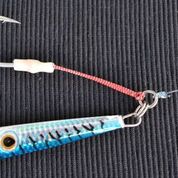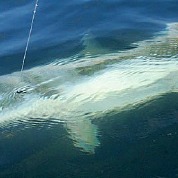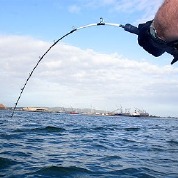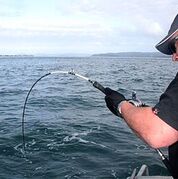
Shane Kelly looks at his earliest introduction to jigging for kingfish, looks back at it’s history and explains how to do it and the gear you need. It seems the best place to start this article is by recalling a day spent livebaiting for kingfish. They would come up and nose into our livebaits but not bite. This went on all afternoon, until, in the end, we gave up and released the livies. As soon as we removed the hooks the kingis swooped in and inhaled the baits.
The mighty kingi, fish of legend and folklore. The toughest, smartest and hardest fighting fish we have resident in New Zealand waters. Tie one tail-to-tail with a marlin the same size and I’ ll wager the king would tow it backwards. Great to fight, great to eat, excellent in the smoker – but the kingfish can also be the most difficult customer to entice into a bite…….until now!
Fight Like Banshees
There’ s a fishing technique that is producing the goods on kingfish in every respect. The kingis can’ t resist – they hit the tackle like runaway freight trains and the fight hard. They tend to be hooked in the mouth – unlike the livebaiting method which tends to gut-hook the kings – and they fight like banshees. Even better – this technique will still take kings in the winter – a time when traditionally it was thought the kingis had shot through. It has proven they are still around; they just weren’ t interested in traditional fishing techniques.

It’ s not unusual to see someone who has hooked a big king on modern tackle get dragged across the boat and slammed against the gunwale as the line screams out through the rod guides. Entertaining to watch and exhilarating when it happens to you. My introduction to this new technique and the tackle came on a charter fishing trip out of Whangarei organised by Boulder Guiding, a company run by keen, semi-retired fisho Graham McKenzie. Several mates joined Dean Marine Charters’ skipper, Dean Musgrove, on his 7m Marco for a day of jigging and softbaiting. The tackle used is very different to what New Zealanders have come to accept as normal. Instead of long 6ft or 7ft fast-taper rods with large reels holding monofilament, jigging equipment features short graphite rods with hardly any taper. They are ‘ parabolic’ meaning they bend from the rod butt right through to the tip. They feature special narrow reels – there’ s no time to lay the line back onto on a wide reel when you’ re connected to an annoyed kingi. The line is braid with amonofilament leader. The terminal tackle is also very different (an explanation will follow later in the article), and ends in a long metal ‘ blade’ jig with a hook tied by a length of Kevlar cord to the top.
The technique involves the use of ‘ mechanical jigging’ where the angler lifts the rod and takes a half or full turn of the reel as the rod tip drops, causing the jig to flutter erratically like a wounded baitfish. There is also a ‘ fake’ mechanical jigging style where the rod is jerked upwards and sideways, then the line is wound down a couple of turns at a time. It’ s an unlikely combination but man, does it work.
Dual Hook Up

Our day with Dean Marine started with a dual hookup. My uncoordinated first-time-out jigging technique managed to snare a large kingfish which promptly wasted me. I grabbed a secondary rod just as another mate hooked up. It ended in tears with about 50m of braid tangled into something that looked like a brightly coloured sparrow’ s nest. Jigging braid is often coloured at regular intervals so the angler can put the jig in front of kings that are holding in midwater. By the time I got it sorted the kingis had moved up river and it was time for a gear retie and a scout round some other likely kingi spots offshore.
I rued my lack of ability to tie a PR knot (the preferred braid to leader knot) without an instruction book in front of me – more practice needed on the bobbin swinging. Hammer down, we bashed our way to Sail Rock to dangle more bits of brightly coloured metal in front of some of the world’ s most powerful and bad tempered fish. The story of how this form of fishing came to New Zealand is taken up by Chris Wong of BCS Enterprises, a business which supplies a full range of jigging tackle. When braided line with its small diameter and zero stretch first became available about 15 years ago, a Japanese fisho called Yoichi Mogi decided to use it while jigging in deep water.
He called the technique “Super Deep-Jigging.” Landing a 35kg bluefin tuna gave him the encouragement to explore the technique further. He popularized the technique in Japan and it caught on around the world. Companies then started producing dedicated tackle – the spindly parabolic rods and narrow spool reels with mega drags as well as a wide range of jigs. The technique popularised by the Japanese is known as ‘ mechanical jigging’ here. Jerking the long jigs up through the water in a series of lifts while part-winding on the reel causes them to flutter, glide and fizz – a wounded baitfish simulation that many fish, especially kingis, find irresistible.

The mechanical jigging style also encourages reactionary strikes by kingfish. When the fluttering jig whizzes past their noses even if they are not actively feeding, they just can’ t resist having a crack at it. They hit hard and fight hard – some say the fight in the kingi is enhanced by the jig hitting the fish in the head – one of the good things about jigging is that the fish are generally mouth hooked so they remain fighting fit and are easily released to fight another day.
Different Gear
If the jigs are different – so too are the rods, which are short and slim, built from mostly graphite and bend right from the butt to the tip. Spiral wrapped rods are popular – with the line guides arranged in a spiral so the top guide hangs beneath the rod – preventing twisting of the blank and ensuring the braid is laid onto the narrow jigging reels properly. The rods are matched to jig weights 100 for use with 100 gram jigs, 250 for use with 250 gram jigs, etc. They tend to be quite soft to impart action to the jigs and with a shorter lever, the fish can’ t put the hurt on the angler – although seeing anglers dragged across the deck and slammed to the gunwale by XXOS kingfish is still a highly entertaining by-product of this type of fishing.

Quite simply, these rods are fantastic fun and a great experience to fish with – you could say the most fun you can have with your pants on. The jigs come in a wide variety of weights, colours, shapes and sizes – and are matched to the rod weight – 150gram jigs on a 150 rod, 250 jigs on a 250 rod and so on. In deeper water a heavier slimmer jig will get to the bottom faster. Centre weighted jigs will plane a lot more as they are jerked and tend to hang and flutter around like a butterfly. Tail weighted jigs tend to flutter less and sink faster and are a good option for deeper water but require more rod action to get them to flutter. The rule seems to be – the bigger the jig, the bigger the predators. And for the tackle-ho, blinged-out jigs, rods and reels seem to be accepted as an integral part of this fishing experience. The high-end jigging reels are widely available in New Zealand and they can cost as much as a full-blown 80-wide game fishing reel. Eggbeater reels are used, but the most popular are overheads with gear ratios of around 4:1. It takes some getting used to but once you have the coordination sussed you will have received an invitation to one of the most exciting styles of fishing ever. The short, lightweight rods, braid line that transmits every bump and jerk of the fish to the angler, and powerful, lightweight reels make for one very exciting experience.
Terminal tackle

If the purpose is to nail large kingfish, the terminal tackle will have to be bulletproof –and even then it may not be enough to stop these powerful and dirty fighters. Braid –mono – jig, how hard can it be? Well, many fights still end in tears. First, the braid to leader knot. The most common braid to leader knot is the PR knot –made with a bobbin that is swung around the line. Wind-on leaders with loop to loop connections are also used. Connecting the line, hook and jig is another whole science. There are six main components – the leader, a connecting ring called a solid ring, the hook, the assist cord, a split ring and the jig.
The leader is tied to the solid ring (which can be oblong in shape, such as the Jigstar brand). The Kevlar assist cord is also connected to this solid ring. The jig is then clipped to the solid ring by a split ring. The assist cord is a loop of Kevlar with the hook at one end and looped onto the solid ring at the other end. The assist cord and hook swing freely from the solid ring. The length of the assist cord is usually about one third to one quarter the length of the jig used. Most jigs come with the assist cord and hook already rigged. However, really keen jiggers like to make their own assist rigs using specialized ultra high quality jigging hooks. With the jig attached to the solid ring by its own split ring, it doesn’ t take any of the strain of the hooked fish (in fact the jig banging against the fish is said to make it fight even harder. The wire loop on top of the jig is not strong enough to handle the load from a fish. The connection from leader to solid ring can be done in various ways – the favourites currently being AG Chain Knot (a long series of half hitches), SG knot, uni knot, wind-on leaders or crimps – preferably with protective thimbles or braid around the ring.
The trace is generally 100 – 150lb or, when you’ re expecting the XXOS models, up to 200lb. When changing jigs the split ring is opened by using a pair of split ring pliers and another jig attached to the same split ring. It’ s worth trying different colours and different shapes of jig because those daft fish really will take one where another fails. This is a basic description only – there is a whole science, art, mumbo jumbo and a whole heap of personal choice as to what works best. In fact, the serious jigger is as hardcore a fisherman as ever existed anywhere – if you ever go into someone’ s garage and there are more than 50 jigs hanging on the wall, some of them repainted by your mate, it’ s time to move rapidly in the other direction.

The range of jigs is enormous, with personal choice the order of the day – although there are definitely times when blue, purple and pink colours work better than others. So how did all this pan out on our Dean Marine Charter? The fish were caught on Katch-1 Knife Jig in blue/silver lumo, Zest Hardy Long blue jig and Zest Slider in purple (Mr McKenzie’ s favourite colour). The fish tended to come in patches – red hot one minute, then quiet. There were three of four fish landed that day at around the 15kg mark (that was a guess, but we actually measured their length and the biggest was 105cm). One was kept for the smoker and the rest returned to once again be tempted by flashing pieces of bling. The kingis took off and it was time to hit the snapper with soft plastics, and those strange little lures worked too – a testament to the very different styles of fishing thathave reached our shores in the last few years.




